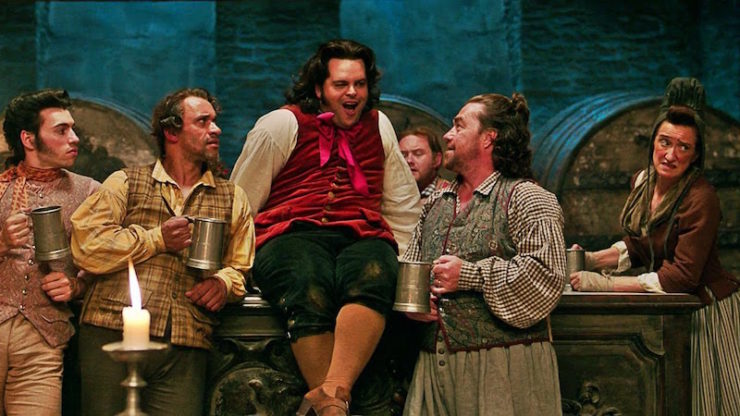The wheels of progress are slow and aggravatingly risk-averse.
The growth of Queer representation in mainstream media has been sluggish as molasses for the past couple of decades, despite the progress made. Stereotypes abound and the roles are slim pickings overall, especially where blockbuster films are concerned—a proverbial no man’s land where the mere idea of a queer personage seems like a dream to many fans.
But there’s a new trend in Hollywood that makes this all the more irritating; the plea for fans to ‘wait and see!’ what scraps of representation they can expect from beloved stories.
There have been wink’n’nudge gay characters slotted into films and television since the inception of both mediums, so it’s no surprise that the trend continues. With the Hays Code in place from the 1930s to the 1960s (which prevented the depiction of homosexuality unless it was portrayed as evil or laughable, among a list of other rules) characters in movies like The Maltese Falcon, Ben-Hur, and Alfred Hitchcock’s Rope were carefully rendered so that nothing was too overt or complimentary in the depiction of gay characters. The code was rescinded after a lax period of enforcement in 1968, leading to more overt portrayals of queer folks, but they were still often rendered as dangerous, villainous, or good for a laugh (see: The X-Files: I Want to Believe, Basic Instinct, and Mrs. Doubtfire, respectively). While the world continues to speed up and make headway, the film industry is utterly nonchalant about their desire to make any films starring queer characters that won’t win heaps of awards—and are therefore typically tragic stories (see: Philadelphia, Brokeback Mountain, The Dallas Buyers Club, etc). Looking for a queer character in a major blockbuster is another matter entirely, despite the vocal efforts of fans to make headway on the issue.
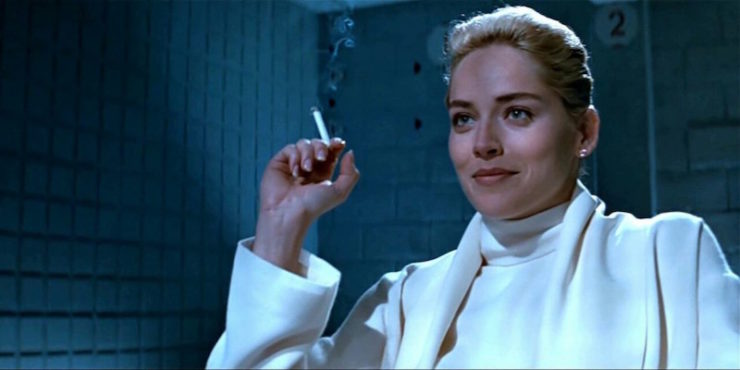
Unfortunately, the desire to better answer the inevitable “what about LGBT characters?” query in interviews has led too many creators to claim that they have offered representation when they haven’t, or that they will soon when they have made no concrete plans to do so. Actors can claim that they are playing characters as though they’re in love, but it doesn’t mean a thing if there’s no confirmation within the text. Graham Norton can tease performers about all the fan art that has been created around a romantic pairing of two characters they portray, but that’s rather like rubbing salt in a wound. The idea of seeing queer relationships in a blockbuster seems light years away when even individual queer characters are so few and far between. Power Rangers was one of the few blockbusters in recent memory to bridge that divide, and even that coming out was covered in a vague scene where Trini, the Yellow Ranger, was less than forthcoming due to being accidentally outed by a lucky guess. Star Trek Beyond managed to give fans a fleeting moment where Hikaru Sulu met up with his husband and daughter, but it was framed largely as an ode to George Takei, the man who originated the role and went on to become something of a gay icon. The industry is still largely at square one.
We can give a bit of credit to animated features of recent years for making baby steps. Laika’s ParaNorman featured the first openly gay character in a major animated film (Mitch, the group’s jock who reveals that he has a boyfriend at the end of the movie), but this is an outlier in terms of creating characters who are clearly queer and present within a narrative. The stories of missed opportunities and misunderstandings keep cropping up; the trailer for Finding Dory caused a kerfuffle when it featured two women around a stroller, and fans leapt to ask whether they were a same-sex couple with their kid. (“They can be whatever you want them to be. There’s no right or wrong answer,” said director Andrew Stanton.) The director of How To Train Your Dragon 2 told fans that the film would have a gay character; this turned out to be Gobber the Belch—voiced by Craig Ferguson—whose sole line to that end was “This is why I never got married. Well, this and one other reason.” Not the most clear-cut declaration, considering that it would sail over the head of a good portion of the audience, especially children. And before anyone makes the comment that children don’t need to see queer characters in fiction: children can be and are queer, and deserve to see people like themselves in stories they care about.
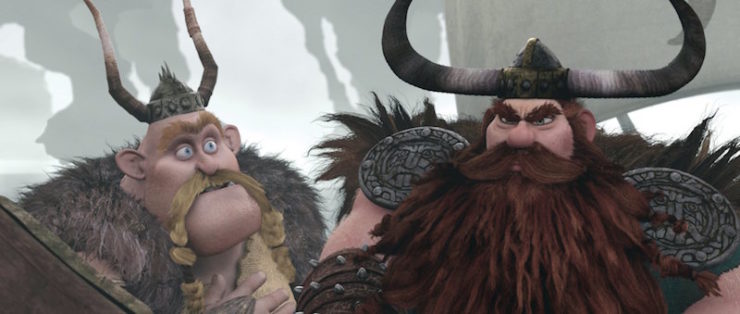
This problem continues to perpetuate itself in the most awkward of ways. Disney’s Frozen came under fire when it was accused of featuring a gay man in a brief supporting role—Oaken, the owner of a trading post who introduces Princess Anna to his family. And while it is fairly clear that the animators were intending to drop that character in under the radar, more direct questions did not yield more direct answers from the film’s co-director and writer Jennifer Lee, who told The Big Issue: “We know what we made. But at the same time I feel like once we hand the film over, it belongs to the world. So I don’t like to say anything, and just let the fans talk. I think it’s up to them.”
Mark Hamill has said much the same regarding his character Luke Skywalker in the Star Wars saga. In an interview back in 2016, he mentioned that fans who were going through trying times in their lives sometimes asked him if Luke could be gay, and his reply was: “I’d say it is meant to be interpreted by the viewer. If you think Luke is gay, of course he is. You should not be ashamed of it. Judge Luke by his character, not by who he loves.” Of course, being an actor who does not own the character he plays, that’s about the kindest thing Hamill could possibly say to that end. But it brings up the same issue; of course Luke can be gay in your head, but the official canon of the story does not align with that point of view, and likely won’t any time soon.
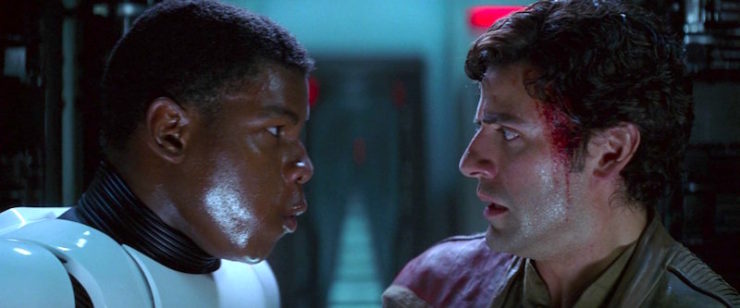
In its stead, Star Wars fans have turned hopeful at the thought of Poe Dameron and Finn ending up together in the current trilogy, but the chances of that are slimmer than anyone is willing to admit. Episode VII director J.J. Abrams can talk all he wants about putting a queer character in the Star Wars universe, but having your two new male leads fall in love would very likely cut into Disney’s profit margins, putting the film at risk for being turned down in national and international markets. A theater in Alabama refused to play Beauty and the Beast after the director told Attitude magazine the film contained an openly gay character; censors in Malaysia wanted four minutes cut from the film, citing a “gay moment” plus a few other innuendos. Losing money from moviegoers across Asia can cost a movie like Star Wars hundreds of millions of dollars in profits; China only screens 34 new releases from overseas each year and competition for those slots is fierce (though the quota could expand). Importantly, depicting gay characters doesn’t result in automatic rejection from these major international markets, and the rules around what is acceptable in entertainment is changing everywhere… but the chances of film companies taking the risk when profits are on the line are not very likely. It’s not right that these are the primary factors in these decisions, but it’s also impossible to ignore that money is Hollywood’s primary goal, and always will be.
Recent examples of how a giant conglomerate like Disney seems intent on answering these questions can be found in Beauty and the Beast and Guardians of the Galaxy 2. The former was directed by a gay man—Bill Condon of Chicago fame—and he revealed to the press circuit before the film’s release that LeFou, Gaston’s tagalong yes-man, would be gay in the film. But the talk around this move was all irritatingly subtle and bogged down in double-talk. Condon assured fans that LeFou would have an “exclusively gay moment” (whatever that means), which would be the “payoff” for LeFou’s confusion around new feelings he was experiencing. Fans shared worries that LeFou might be into Gaston—a likelihood when you take in Condon’s statement that “LeFou is somebody who on one day wants to be Gaston and on another day wants to kiss Gaston”—making Disney’s first openly gay character besotted with a despicable villain.
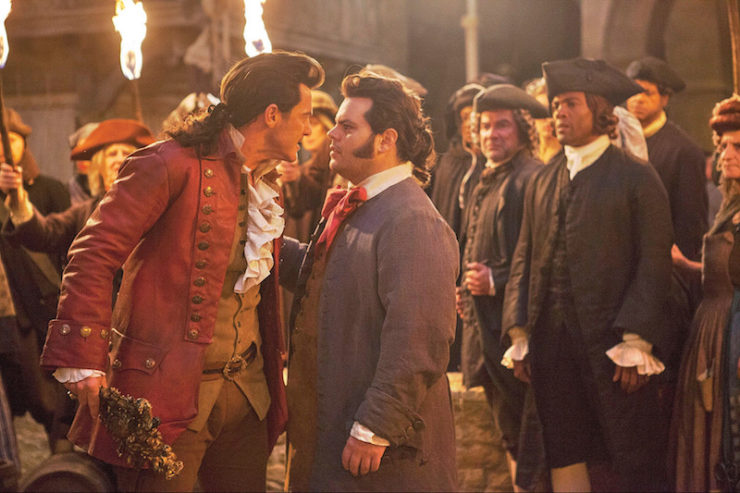
When the film was released, it turned out to be far more subdued than that; one of the strapping young villagers gets a makeover from the wardrobe during the film’s final battle… and he clearly likes his new dress and makeup regime. Then the same fellow spins himself into Le Fou’s arms at the end of the movie and the two begin to dance. Hardly a great big neon sign, especially given that it was perfectly acceptable for straight men to dance together in social settings in centuries past. (That would be why no one blinks an eye when Sherlock Holmes and Dr. Watson danced together in A Game of Shadows.)
Trouble arose again when James Gunn was asked whether or not there would be LGBT characters in Guardians of the Galaxy Vol. 2. His reply was annoyingly obtuse as well, to the point of insult: “Absolutely. I would love to be able to. We might have already done that. I say watch the movie. Check it out. See what you think.” We might have? See what you think? What does that even mean? Those who have seen the movie know that there is likely only one possibility on that front; a couple of the ravagers are seen spooning in a scene before a whole crew of them are brutally murdered by Yondu and Rocket. This is after said group of ravagers torture little Groot seemingly for fun. As examples of LGBT+ representation go, this possibility was both hamfisted and barely fleshed out or developed, in addition to the potential queer characters in question being abusive criminals who torture a baby tree, and are then killed off.
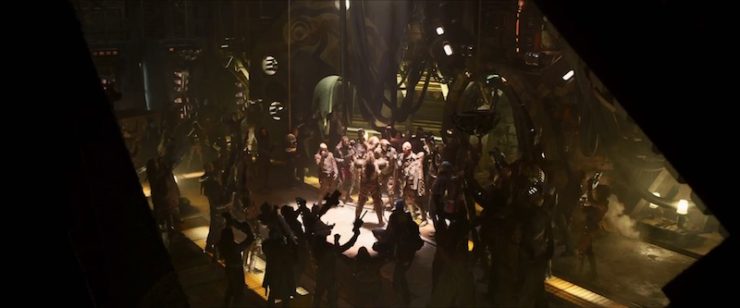
Realizing the faux pas, Gunn later walked back the statement in an interview with Digital Spy: “What I meant to say is this: There are a lot of gay people in the world. There are a lot of bisexual people in the world. There are a lot of characters in the MCU. We’ve barely gotten to know the sexuality of any of those characters. We know Gamora and Quill are interested in each other. That’s about the only sexual relationship that exists within the Guardians. We know Drax has a past with a wife so he’s got some sort of interest in women. But we don’t really know who’s gay and who’s not. It could be any of them.”
In other words, Hey, we might address that at some point in time (though there are no plans to), but for now, it could be anyone! That’s great, right?
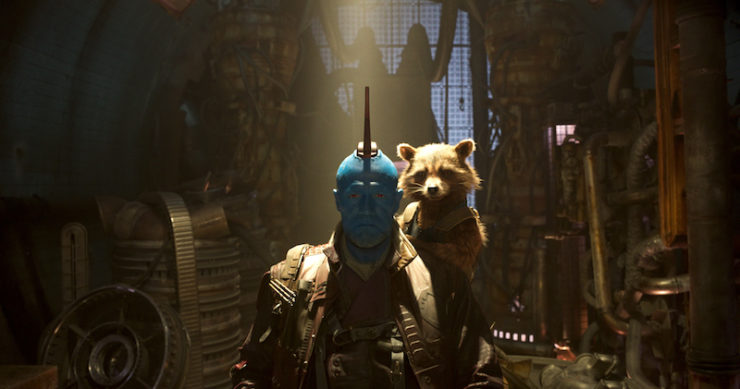
Mind you, this was already two years after Marvel Studios president Kevin Feige claimed that he thought there would be an LGBT character added to the MCU… within the next ten years or so. By that point (in the year 2025), the Marvel Cinematic Universe will have likely produced two or three films a year for nearly two flipping decades, and only then will we finally (maybe) see a queer superhero on a movie screen. Feige deflected the question further by pointing out how they often look to the source material for inspiration on the films, but given the slim pickings in Marvel Comics canon (and the fact that more than one LGBT superhero falls into the X-Men pantheon, which 20th Century Fox has the rights to), they’re going to have to work a little bit harder on appeasing LGBT fans, canonical material or no.
The difficulty with this form of will-they-won’t-they representation should be clear. It means that anyone is free to project whatever they like upon a character—which fans already do regardless, as the world of fanfiction and fan art proves—but it also means that queer fans do not have a solid example that they can hold up to their friends, family, and peers. It is representation by omission, imagination, and hope. It is the equivalent of walking an invisible dog. You might briefly feel as though you own a pet, but no one else can see it or interact with it, so it’s eventually pretty obvious that you don’t have one.
Oh, by the way, there is one technical bit of representation in the Marvel Cinematic Universe—it’s in the one-shot titled “All Hail the King,” a short film starring Ben Kingsley’s Trevor Slattery (Iron Man 3), with a brief cameo from Sam Rockwell as Justin Hammer. Both characters are in prison, and at the end we see the former weapons mogul attended to by a young man who attempts to cuddle him as Hammer complains about how he used to own a boat. When the younger inmate gets too close, Hammer says to him, “Not here, baby, not here.” So Justin Hammer is apparently bisexual, or maybe just bisexual in prison, and also hey, let’s make light of sexual abuse in prisons while we’re at it, and have this be the only example of open queerness in this fictional universe.
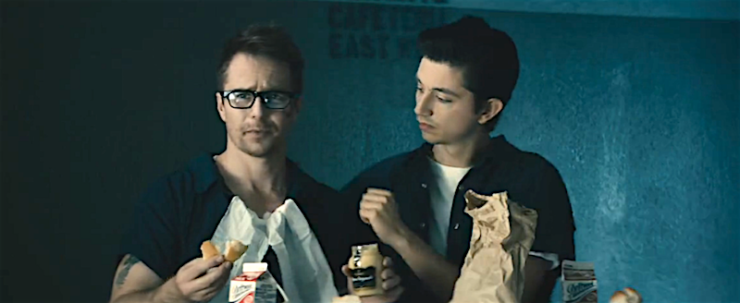
It’s fine if you’re gay, as long as you’re okay being the butt of an incredibly damaging joke.
Look, queer fans of these multibillion dollar franchises aren’t asking for much. They would like a few reflections among a vast sea of sameness, something that lets them know that there is a place for them in the worlds they adore. No one expects the companies that own these stories to look beyond their wallets, and that’s part of the problem; you can talk about how it’s all about the money, but that answer isn’t good enough. It shouldn’t be good enough. And if it is, these creators and producers and directors deserve every complaint and awkward question that fans throw their way—because these patient devotees deserve better.
No one should have to “wait and see!” if their humanity counts.
Emmet Asher-Perrin is going to create her own blockbuster franchise titled “Queer and Present Danger.” You can bug her on Twitter and Tumblr, and read more of her work here and elsewhere.










